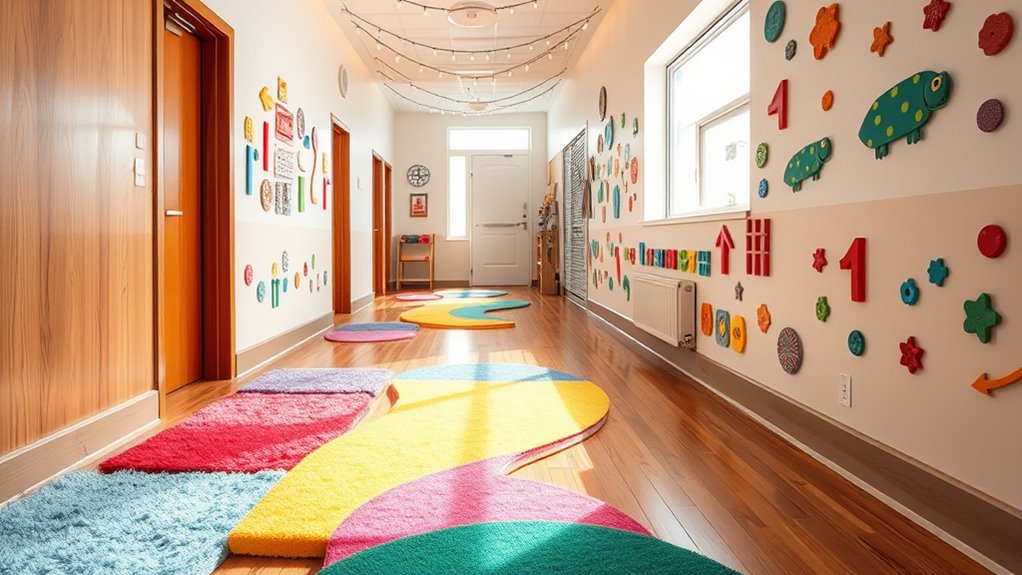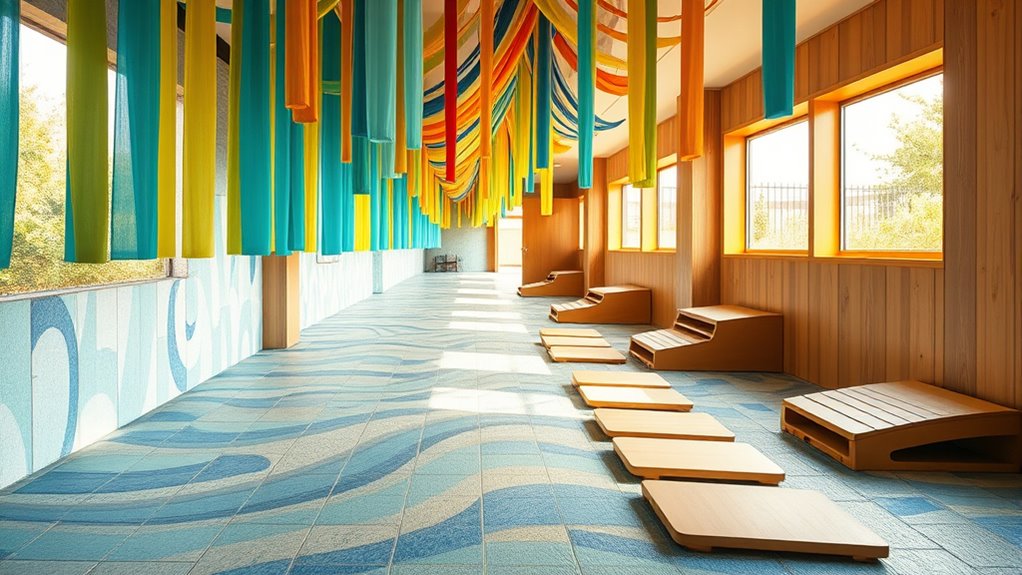To create a sensory path in your hallway, map out a route with textured, colorful elements like mats, stepping stones, and zigzag tape. Incorporate activities such as jumping, crawling, balancing, and sensory challenges like textured surfaces or auditory cues. Use clear visual guides to help children follow the path independently and adjust the difficulty to suit different needs. Keep safety in mind and make sure each activity is fun. Keep exploring to discover more ideas for an engaging sensory experience.
Key Takeaways
- Map out a route with textured, colorful, and challenging elements like lines, zigzags, and circles using tape or mats.
- Incorporate movement activities such as hopping, crawling, and heel-to-toe walking to promote sensory integration.
- Add tactile surfaces like bubble wrap or patterned rugs and visual cues like arrows to guide children through the path.
- Include balance challenges with stepping stones, balance beams, and soft mats to develop coordination and motor skills.
- Ensure safety with non-slip materials, lightweight components, and regular supervision to adapt activities to different skill levels.

If you’re looking for a fun and effective way to engage your child’s senses at home, creating a sensory path in your hallway is a great option. A sensory path offers a structured way to promote sensory integration, helping your child improve their coordination, balance, and focus through movement activities. These paths are designed to stimulate multiple senses while encouraging physical activity, making them perfect for kids who need additional sensory input or just love to move.
Create a fun sensory path at home to boost coordination, balance, and focus through movement and sensory activities.
You can start by mapping out a simple route that weaves through your hallway, incorporating different textures, shapes, and challenges. Use tape or lightweight mats to create lines, zigzags, or circles on the floor. Incorporate various movement activities like hopping on one foot, walking heel-to-toe, or crawling through tunnels made from cardboard boxes. These activities serve as sensory input, aiding in sensory integration by strengthening neural connections between the brain and body. As your child moves through the path, they engage their proprioceptive and vestibular systems, which can help regulate their mood and improve focus.
Adding textured surfaces enhances the sensory experience. For example, you can tape down a section with bubble wrap for popping, or place a rug with a different fabric pattern. Incorporate elements like stepping stones, balance beams, or soft mats to challenge their balance and motor planning. You might also include activities like jumping over small obstacles or crawling under a row of hanging scarves. These movement activities are not only fun but also serve as essential sensory input, especially for children with sensory processing challenges.
You should also think about using visual cues along the path to guide your child’s movements. Bright colors, arrows, or simple instructions can help them understand the activity for each section. This encourages independence and helps your child develop sequencing skills as they follow the path. Adding auditory elements, like a bell or musical chime at certain points, can further stimulate their senses and make the experience more engaging.
Incorporating sensory input through varied textures and activities can help strengthen neural pathways, making the sensory path even more beneficial. Finally, keep the sensory path flexible and safe. Monitor how your child interacts with each part, adjusting the difficulty or textures as needed. Remember, the goal is to make movement activities enjoyable and beneficial, promoting sensory integration while giving your child a chance to burn off energy in a controlled, accessible way. By creating a sensory path, you’re providing a dynamic tool that supports sensory development and encourages active, healthy play within your home.
Frequently Asked Questions
What Safety Considerations Should I Keep in Mind?
You should start with safety assessments to identify potential hazards. Make sure the flooring is non-slip to prevent falls, especially in high-traffic areas. Keep the sensory path clear of obstacles and secure all materials firmly to avoid trips. Regularly inspect the setup for wear and tear. Adequate lighting is essential, and consider padding or cushioning in case of falls. These steps help create a safe, enjoyable sensory experience.
How Much Space Is Needed for a Sensory Path?
A sensory path is like a mini adventure, so you’ll want enough space to make it fun and safe. Typically, you’ll need about 10 to 15 feet of length and 3 to 6 feet of width, depending on your layout options. Consider available space, activity variety, and safety zones. You can customize the layout to fit your hallway’s dimensions, ensuring there’s enough room for kids to move freely without feeling cramped.
Can I Customize the Sensory Activities?
Yes, you can customize the sensory activities to suit your needs. With personalization options and activity modification, you can tailor each station to target specific sensory skills or preferences. Whether you want more calming activities or energetic challenges, adjusting the activities is easy. This flexibility guarantees your sensory path remains engaging and effective for everyone who uses it, making it a versatile addition to your hallway.
What Age Groups Benefit Most From a Sensory Path?
You’ll find that children of all ages benefit from a sensory path, especially preschoolers and elementary students, as it supports their developmental benefits. It offers activity variety that helps improve motor skills, coordination, and focus. For younger kids, it promotes sensory processing, while older children gain balance and agility. Tailor your sensory path to suit different age groups, ensuring each child receives appropriate stimulation and developmental support.
How Do I Maintain and Clean the Sensory Path?
You should regularly clean your sensory path by implementing simple cleaning routines like wiping down surfaces with a damp cloth and using gentle cleaners. Maintenance tips include inspecting the path for wear and tear, replacing worn-out materials promptly, and ensuring all elements are secure. By staying consistent with cleaning routines and checking for damage, you keep the sensory path safe, engaging, and inviting for children to use daily.
Conclusion
Transform your hallway into a vibrant, vivid voyage of movement and mindfulness. With a thoughtful sensory path, you invite wonder and wellness into your home, fueling fun and focus. Let each step spark a spectrum of sensory sensations, turning routine routines into delightful discoveries. Embrace the excitement of creating your own colorful, calming corridor—where footsteps flow, and senses soar. This simple, sensory setup transforms everyday spaces into spectacular, sensory-filled sanctuaries.










